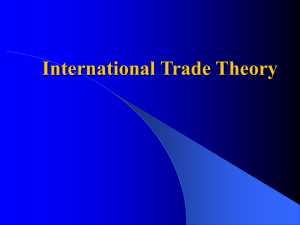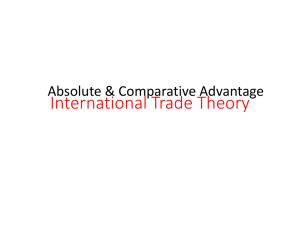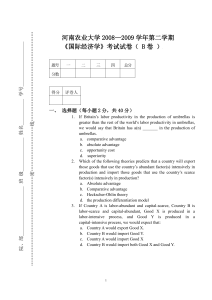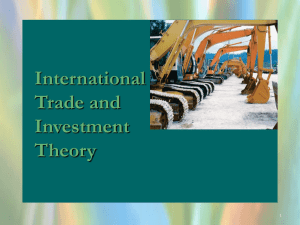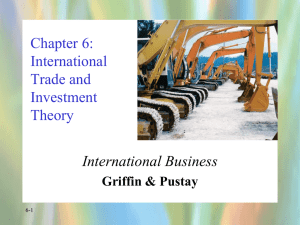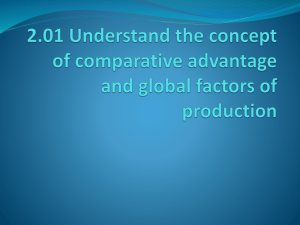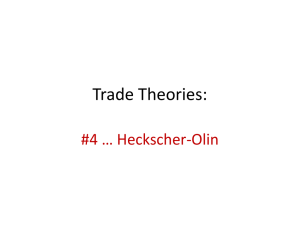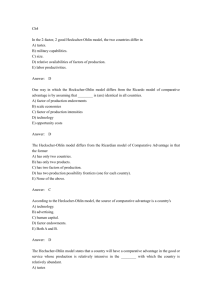Chapter 3
advertisement
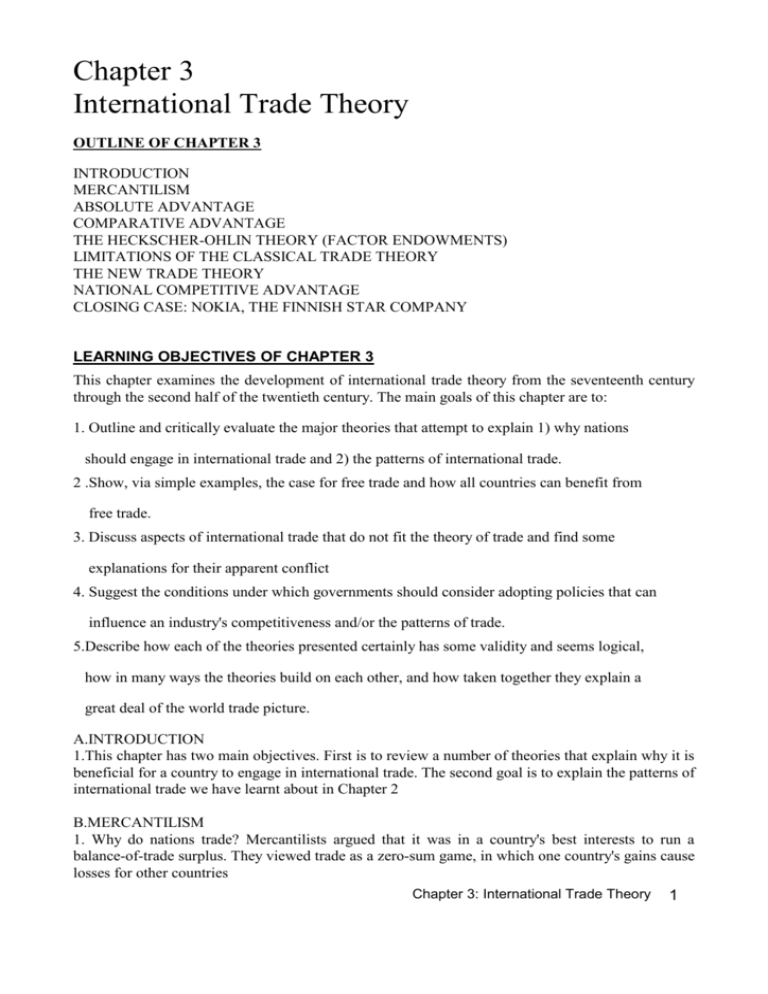
Chapter 3 International Trade Theory OUTLINE OF CHAPTER 3 INTRODUCTION MERCANTILISM ABSOLUTE ADVANTAGE COMPARATIVE ADVANTAGE THE HECKSCHER-OHLIN THEORY (FACTOR ENDOWMENTS) LIMITATIONS OF THE CLASSICAL TRADE THEORY THE NEW TRADE THEORY NATIONAL COMPETITIVE ADVANTAGE CLOSING CASE: NOKIA, THE FINNISH STAR COMPANY LEARNING OBJECTIVES OF CHAPTER 3 This chapter examines the development of international trade theory from the seventeenth century through the second half of the twentieth century. The main goals of this chapter are to: 1. Outline and critically evaluate the major theories that attempt to explain 1) why nations should engage in international trade and 2) the patterns of international trade. 2 .Show, via simple examples, the case for free trade and how all countries can benefit from free trade. 3. Discuss aspects of international trade that do not fit the theory of trade and find some explanations for their apparent conflict 4. Suggest the conditions under which governments should consider adopting policies that can influence an industry's competitiveness and/or the patterns of trade. 5.Describe how each of the theories presented certainly has some validity and seems logical, how in many ways the theories build on each other, and how taken together they explain a great deal of the world trade picture. A.INTRODUCTION 1.This chapter has two main objectives. First is to review a number of theories that explain why it is beneficial for a country to engage in international trade. The second goal is to explain the patterns of international trade we have learnt about in Chapter 2 B.MERCANTILISM 1. Why do nations trade? Mercantilists argued that it was in a country's best interests to run a balance-of-trade surplus. They viewed trade as a zero-sum game, in which one country's gains cause losses for other countries Chapter 3: International Trade Theory 1 2. Although mercantilism was superseded by classical economic theory, many political views today have the goal of boosting exports while limiting imports by seeking only selective liberalization of trade. C.ABSOLUTE ADVANTAGE 1. The theory of absolute advantage suggests that countries differ in their ability to produce goods efficiently. Adam Smith showed that a nation would export goods that it could produce with less labour than other nations, in other words that a country should specialize in producing goods in areas where it has an absolute advantage and import goods in areas where other countries have absolute advantages. 2. According to Absolute Advantage theory, trade is a positive sum game. D.COMPARATIVE ADVANTAGE 1.Ricardo proved that even though less efficient than other nations, a nation could still profit by exporting goods. 2. The theory of comparative advantage suggests that it makes sense for a country to specialize in producing those goods that it can produce most efficiently, while buying goods that it can produce relatively less efficiently from other countries-even if that means buying goods from other countries that it could produce more efficiently itself. 3.One should distinguish between Comparative advantage and Competitive advantage. Comparative advantage , as explained above, refers to the cost of producing some product or service in one country versus another. It is a concept based on relative cost of production (and opportunity cost) between nations. Competitive advantage refers to any characteristics (skill or capability) held by a firm that enables it to achieve lower costs, higher revenues, or lower risk than its competitors. It is a concept used to compare two companies abilities to compete in the same business. E. THE HECKSCHER-OHLIN THEORY(FACTOR ENDOWMENTS) 1. A country's share of factors of production is referred to as its factor endowment. Most countries possess some factors in greater abundance than others 2. The Heckscher-Ohlin theory argues that the pattern of international trade is determined by differences in factor endowments. It predicts that countries will export those goods that make intensive use of locally abundant factors and will import goods that make intensive use of factors that are locally scarce. F. LIMITATIONS OF THE CLASSICAL TRADE THEORY 1.The theory of comparative advantage in international trade does not take into account a number of considerations such as: the difficulty in moving resources, especially the labour force, into the desired industries; fluctuations in demand, or the collapse of a market in a country's product, in a situation of international recession or unfair (i.e. subsidised) competition; artificial limitations (e.g. import restrictions) placed on a product by overseas countries; other political restraints. 2 International Trade and investment: Student’s Workbook G. THE NEW TRADE THEORY 1. The new trade theory argues that a country may predominate in the export of a certain product simply because it had a firm that was a first mover in an industry that will profitably support only a few firms because of substantial economies of scale. 2. Some new trade theorists (e.g. Paul Krugman) have promoted the idea of strategic trade policy. The argument is that government, by a judicious use of subsidies, might be able to increase the chances of domestic firms becoming first movers in newly emerging industries. Best example is the aircraft industry, with companies like Boeing or Airbus. H. NATIONAL COMPETITIVE ADVANTAGE 1. Why do nations trade? Mercantilists argued that it was in a country's best interests to run a balance-of-trade surplus. They viewed trade as a zero-sum game, in which one country's gains cause losses for other countries. 2. The theory of absolute advantage suggests that countries differ in their ability to produce goods efficiently. Adam Smith showed that a nation would export goods that it could produce with less labour than other nations, in other words that a country should specialize in producing goods in areas where it has an absolute advantage and import goods in areas where other countries have absolute advantages. 3. Ricardo proved that even though less efficient than other nations, a nation could still profit by exporting goods. The theory of comparative advantage suggests that it makes sense for a country to specialize in producing those goods that it can produce most efficiently, while buying goods that it can produce relatively less efficiently from other countries-even if that means buying goods from other countries that it could produce more efficiently itself. 4. The theory of comparative advantage suggests that unrestricted free trade brings about increased world production and consumption; that is, that trade is a positive-sum game. 5. The Heckscher-Ohlin theory argues that the pattern of international trade is determined by differences in factor endowments. It predicts that countries will export those goods that make intensive use of locally abundant factors and will import goods that make intensive use of factors that are locally scarce. 6. The new trade theory argues that a country may predominate in the export of a certain product simply because it had a firm that was a first mover in an industry that will profitably support only a few firms because of substantial economies of scale. 7. Some new trade theorists (e.g. Paul Krugman) have promoted the idea of strategic trade policy. The argument is that government, by a judicious use of subsidies, might be able to increase the chances of domestic firms becoming first movers in newly emerging industries. Best example is the aircraft industry, with companies like Boeing or Airbus. 8. Porter's theory of national competitive advantage suggests that the pattern of trade is influenced by four attributes of a nation: (i) factor endowments, (ii) domestic demand conditions, (iii) relating and supporting industries, and (iv) firm strategy, structure, and rivalry. Two additional elements are : Chance and government Chapter 3: International Trade Theory 3 9. Porter’s diamond theory still needs some independent empirical testing. But all in all it is a solid concept which complements the other theories of trade. While modern experts have some reservations about certain assumptions of the classical theory of trade, they tend to agree that free trade is still the best option for the world economy. PRACTICE ACTIVITIES True-False Questions 1. In the absence of trade, a nation’s production possibility frontier is the same as its consumption frontier. T/F 2. According to the theory of free trade, a tropical country which can produce winter T/F coats, but has no domestic demand for them, will never be able to export winter coats 3.The exchange rate is not important in the theory of comparative advantage T/F 4.The theory of comparative advantage indicates that trade is a positive sum game. T/F 5.The Heckscher-Ohlin theory predicts that a country will export those goods that make intensive use of factors that are locally scarce and will import those goods that make intensive use of factors that are locally abundant. T/F 6. The new trade theorists have supported the idea of government intervention in favour of certain big domestic firms in order to become first movers in newly emerging industries. T/F 7. The new trade theory has nothing to do with cost theories. T/F 8. Harvard studies suggest that first mover advantages are important in explaining the dominance of firms in certain industries such as the consumers electronics industry and jet engine industry. T/F 9. One implication suggested by the new trade theory is that governments should consider strategic trade policies. T/F 10. Porter’s theory found four attributes that promote or impede the creation of comparative advantage. T/F Multiple Choice 1.According to mercantilism a. Government has no role in trade b. Trade is a positive sum game c. A country should consistently run a balance–of–trade surplus d. Free trade is the best form of trade 4 International Trade and investment: Student’s Workbook 2. The table below shows the number of output units produced by 100 units of inputs in Bucksland and New Zetland. VCRs Wine Bucksland 50 400 New Zetland 100 600 According to the cost theories of trade, which of the following statements is NOT true: a. New Zetland has an absolute advantage in both commodities b. New Zetland should specialise in VCRs c. Bucksland has the least comparative disadvantage in wine d. For Bucksland it is more advantageous to import wine and export VCRs 3. Looking at the various trade theories and the growth of intra-industry trade as a percentage of international trade, which statement is the most correct a. The theory of free trade can fully explain the growth of the intra-industry trade. b. The strong growth of trade in manufactured goods between industrialised countries shows that they trade increasingly in homogenous goods c. Most of the trade between industrialised and developing countries is inter-industry trade based on differences in factor endowments as postulated by Ricardo’s theory of comparative advantage d. An increasing proportion of the trade between industrialized countries is intra-industry trade in differentiated products as postulated by the new trade theories. 4. Which of the following is NOT one of the four main attributes listed by Porter’s diamond theory as influencing a nation’s patterns of trade: a. factor endowments b. domestic demand conditions c. government support d. relating and supporting industries Chapter 3: International Trade Theory 5 SOLUTIONS TO PRACTICE ACTIVITIES True-False Questions 1. T 6. T 2. F 7. F 3. T 8. T 4. T 9. T 5. F 10. F Multiple Choice 1. C 2. D 3. D 4. C 6 International Trade and investment: Student’s Workbook
